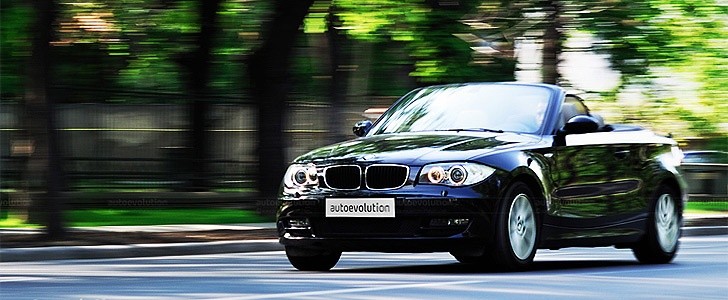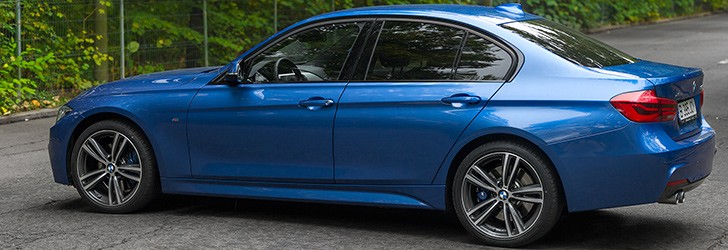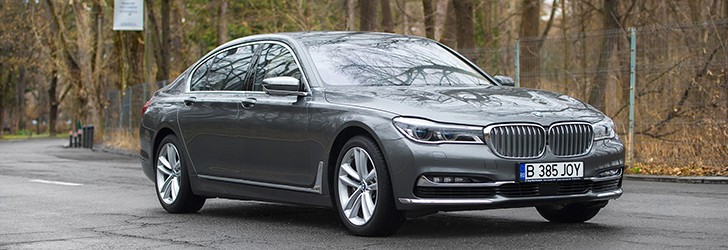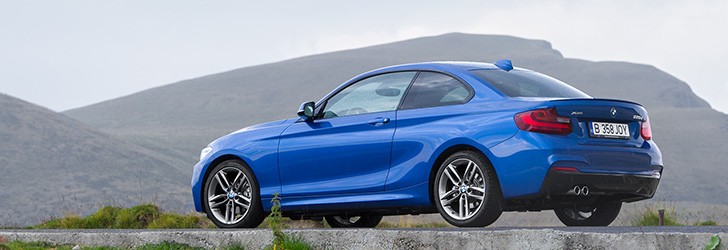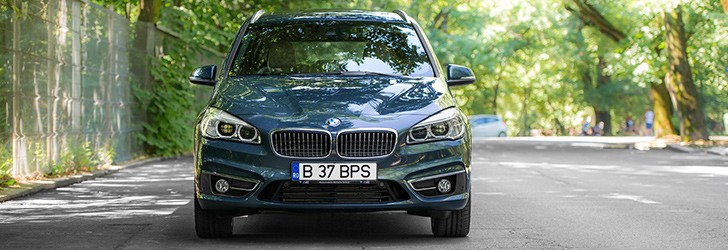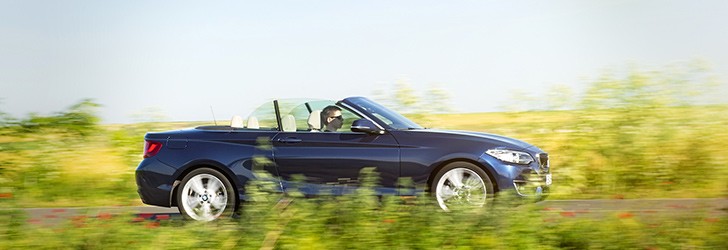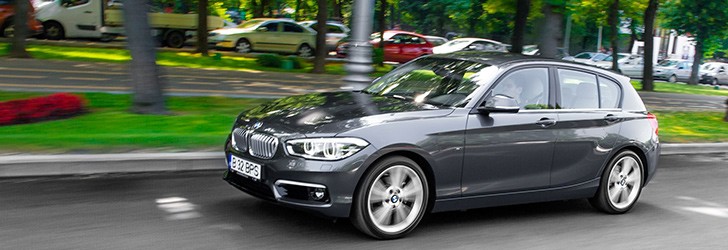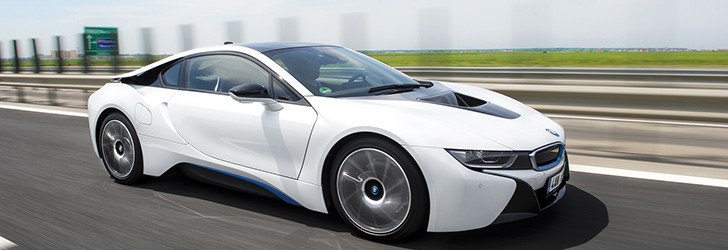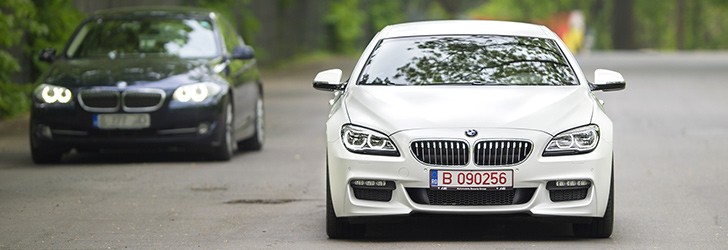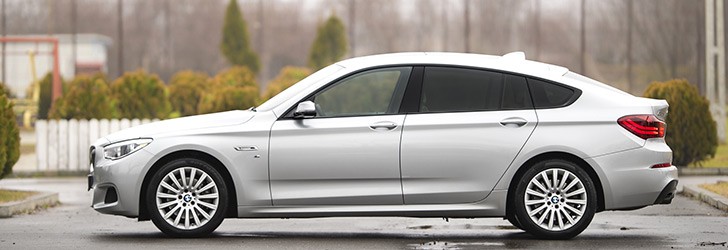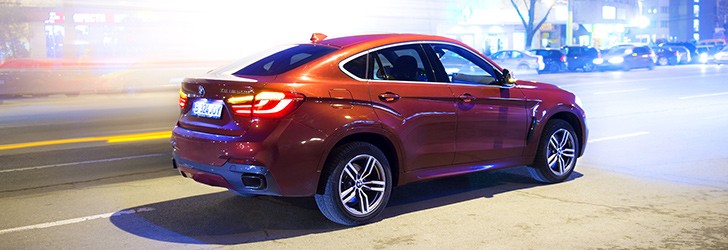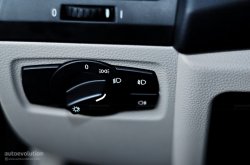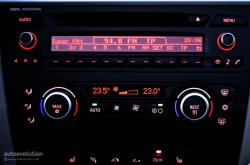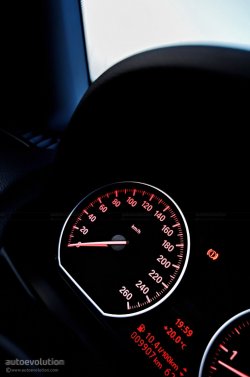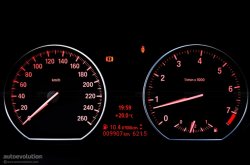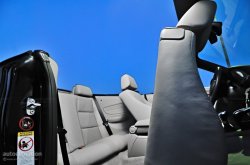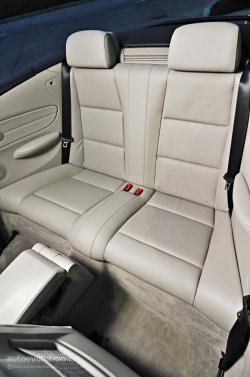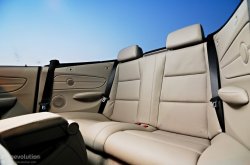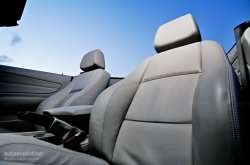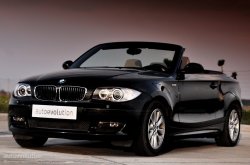BMW 120i Cabriolet Review
OUR TEST CAR: BMW 120i Cabriolet
Just like the non-facelifted 1-Series hatchback and pretty much all the other BMW models manufactured since 2004 or so, our 120i Cabriolet was equipped in standard with run-flat tires and no spare tire, thus making room for the car's battery to reside under the luggage compartment. Technically this means two a bit antithetic things.
First of all, the car's dynamics are very close to a real sports car, since the axle weight ratio is close if not even identical to a 50:50 distribution. Second of all, because of the same reasons the car is stiffer than you would expect from a leisure convertible that won't be used to break any records on the Nordschleife.
Apart from the aforementioned, the car's suspension is closer to "rigid" than to "cushy" on the comfort scale. Don't get us wrong, the suspension setup won't give you back pains on a daily basis but the fact remains, even in 120i trim, the 1-Series is still very close to a sports car. Apart from the obvious throttle and steering wheel, the onboard "pleasure givers" were pretty much kept to a minimum on our test car.
It had a dual-zone climate control system which works pretty well regardless of the position of the roof as long as the windows and/or the wind blocker are up, a BMW Professional audio system and that's pretty much it. The seats were manually adjustable except for a very interesting feature. That was the electrically adjustable side bolster support for both front seats, which technically changes the seats' shape around you just by pressing a button. Therefore, they can accommodate almost anything, from the thinnest guy/gal out there to a pretty large person.
Other than that, there's the leather upholstery on the seats, which didn't quite blow us away with its look and/or feel. Maybe it was because it was UV treated or something, but it wasn't exactly as soft as a baby's bottom.
Although not as economical as we would have thought just by taking BMW's word on it, the two-liter 170 horsepower engine is pretty much all that you'd want from a modern engine. Speaking of fuel economy, we averaged 10.4 liters per 100 kilometers (US 22.6 mpg) during the whole period in which we drove the car. Taking into account the fact that we didn't quite drove in a very economical fashion the whole time and the time we spent in the city was full of sudden accelerations followed by stops, we think that's a pretty good number for a normally aspirated and high-revving two-liter engine.
Not even close to the 6.6 liters (US 35.6 mpg) BMW was apparently expecting, but pretty good nonetheless, especially given the conditions. What we really liked about it were the BMW DNA traits which, minus a few, are still present even in a modern Bavarian engine. The lack of low end grunt is compensated by the minor storm coming right after you pass 3500-4000 rpm.
Fitted with direct injection and BMW's Valvetronic system, the power plant also sadly managed to disappoint us in the "hi fi department". Especially with the top down, the four-banger sounds way too antithetic to the oldschool Bavarian inline engines. We don't know if it's the lack of two more cylinders or the direct injection, but it was probably the first petrol engine from Munich to not sound like it's supposed to. Okay, maybe the dying cat comment earlier on is a bit too much, but it still didn't tickle our hearing in a very good way.
The six speed manual transmission does its job pretty well, although we would have preferred if it was more of a short shift, considering the fast-revving nature of the engine. Also, its gearing was a bit on the tall side, with more fuel-friendly than acceleration-friendly ratios.
Just like pretty much all BMWs, Audis and Mercedes-Benzes with a small engine, the 120i Cabriolet doesn't come with that many features as standard. Thankfully, our test car wasn't exactly standard trim and we can feature some of its useful gizmos in a longer list than the one we had for our BMW 320xD Touring test car. Naturally, some of them are standard while most of the more interesting ones are optional.
For starters, having an electrically foldable roof as standard is not much of a premium feature on convertible cars anymore, but it's still a useful feature nonetheless. We didn't like the fact that you're required to keep the open or the close button pressed for the whole time while the car is letting its "hood" up or down. The nice part about it is the fact that you can open or close the roof even while the car is running, although it can only be done at up to speeds of 40 km/h (25 mph).
A nice surprise was the automatic function of the xenon headlights, which apparently works even if the lights switch isn't set on "Auto". For the forgetful persons (cough! Tudor Raiciu cough! our photographer cough!) this can actually come in handy when driving away at night and other car's headlights from behind give you the impression that they are your own.
Although the seats were completely manually adjustable, we were flabbergasted in a good way by the side bolster support electrical adjustment option. In plain English, you can adjust the width and the level of side support for both front seats, which is a pretty cool thing if more than one person will be driving the car, assuming they are differently-sized.
Other than this, the only useful gadget worth mentioning might be the front and rear parking sensors, which can get you out of a lot of trouble if you're not the best person to parallel-park a car in a short space.
Whenever talking about the safety of a convertible, most people's self preservation instinct starts talking for them. Not to say that is wrong, or that we have a completely different opinion on the subject, but in general, things are not as grim as they appear. The BMW 1-Series Cabriolet is built on exactly the same platform as the 1-Series hatchback and shares more than a few technical bits with the current 3-Series sedan (E90). Both these related cars have a five-star rating at EuroNCAP and went through several crash tests with flying honors.
This, of course, doesn't mean that a convertible version should be just as protective to its occupants, especially considering the fact that the whole roof has been chopped off, therefore modifying the whole crash structure and the passengers cell with it. Still, like pretty much every convertible-maker out there, the 1-Series underbody structure has been stiffened for two highly logical reasons.
First of all, by chopping the body and leaving it with a foldable canvas roof, a car is more prone to bending forces. So, the underbody is stiffened in order for the car to handle at least as well as its coupe version. The other reason is, obviously, crash protection.
On top of this, our test car was fitted with four airbags, two dual-stage frontal ones and two for side impact protection and the regular anti-lock braking system and electronic stability program. But what would happen in the unfortunate event of a rollover, you might ask?
Well, first of all the A-pillar is roughly twice or thrice as stiff as the one from the 1-Series Coupe, while behind the two rear headrests is a "Jumpin' Jack Flash" kind of surprise just waiting for the right time to pop out. Two magnesium roll-bars painted in the same color as the interior and not looking like a roll-bar at all will automatically pop out in a fraction of a second whenever the car's gyroscopic sensor will acknowledge an imminent rollover.
Having driven the 120i Cabrio for a number of miles we can only say that its most interesting and catchy feature was bound to be the convertible roof. There can't be any other possible reason for someone to buy a 120i Cabrio instead of its coupe or hatchback sibling. Apart from visibility there couldn't be any other plausible or practical basis behind someone's decision to choose the topless version of the BMW 1-Series. The joy of open top motoring is simply unquantifiable, and in the world of premium entry-level convertibles, the 120i is simply one of the best. In other words, its best feature is obviously its most observable: the cabriolet roof.
The coupe version of the 1-Series would get even lower marks in this department but the Cabrio isn't that far either. We think that the two rear seats were put there just for the rare case when your two hobbit friends need a ride. They're not exactly unusable, but you'd have to be a real masochist to sit on them for a longer period of time. For the rest of the time, their best use would be that of carrying the extra shopping bags that didn't fit in the rather unpractical luggage compartment.
The ugly part about our test drive had to be the high-revving, almost torque-less engine. Don't get us wrong, we weren't born in a 500 hp turbocharged supercar to judge every other car since then by its standards, but the two-liter mill under the hood would need constant winding up in order to provide a more pleasurable drive. If you drive it like a Sunday driver all the time, admiring the scenery with the top down you'll be fine, but if you really want the sportiness of a BMW you need to rev it more than other cars with comparable horsepower.
First of all, the car's dynamics are very close to a real sports car, since the axle weight ratio is close if not even identical to a 50:50 distribution. Second of all, because of the same reasons the car is stiffer than you would expect from a leisure convertible that won't be used to break any records on the Nordschleife.
Apart from the aforementioned, the car's suspension is closer to "rigid" than to "cushy" on the comfort scale. Don't get us wrong, the suspension setup won't give you back pains on a daily basis but the fact remains, even in 120i trim, the 1-Series is still very close to a sports car. Apart from the obvious throttle and steering wheel, the onboard "pleasure givers" were pretty much kept to a minimum on our test car.
It had a dual-zone climate control system which works pretty well regardless of the position of the roof as long as the windows and/or the wind blocker are up, a BMW Professional audio system and that's pretty much it. The seats were manually adjustable except for a very interesting feature. That was the electrically adjustable side bolster support for both front seats, which technically changes the seats' shape around you just by pressing a button. Therefore, they can accommodate almost anything, from the thinnest guy/gal out there to a pretty large person.
Other than that, there's the leather upholstery on the seats, which didn't quite blow us away with its look and/or feel. Maybe it was because it was UV treated or something, but it wasn't exactly as soft as a baby's bottom.
Although not as economical as we would have thought just by taking BMW's word on it, the two-liter 170 horsepower engine is pretty much all that you'd want from a modern engine. Speaking of fuel economy, we averaged 10.4 liters per 100 kilometers (US 22.6 mpg) during the whole period in which we drove the car. Taking into account the fact that we didn't quite drove in a very economical fashion the whole time and the time we spent in the city was full of sudden accelerations followed by stops, we think that's a pretty good number for a normally aspirated and high-revving two-liter engine.
Not even close to the 6.6 liters (US 35.6 mpg) BMW was apparently expecting, but pretty good nonetheless, especially given the conditions. What we really liked about it were the BMW DNA traits which, minus a few, are still present even in a modern Bavarian engine. The lack of low end grunt is compensated by the minor storm coming right after you pass 3500-4000 rpm.
Fitted with direct injection and BMW's Valvetronic system, the power plant also sadly managed to disappoint us in the "hi fi department". Especially with the top down, the four-banger sounds way too antithetic to the oldschool Bavarian inline engines. We don't know if it's the lack of two more cylinders or the direct injection, but it was probably the first petrol engine from Munich to not sound like it's supposed to. Okay, maybe the dying cat comment earlier on is a bit too much, but it still didn't tickle our hearing in a very good way.
The six speed manual transmission does its job pretty well, although we would have preferred if it was more of a short shift, considering the fast-revving nature of the engine. Also, its gearing was a bit on the tall side, with more fuel-friendly than acceleration-friendly ratios.
Just like pretty much all BMWs, Audis and Mercedes-Benzes with a small engine, the 120i Cabriolet doesn't come with that many features as standard. Thankfully, our test car wasn't exactly standard trim and we can feature some of its useful gizmos in a longer list than the one we had for our BMW 320xD Touring test car. Naturally, some of them are standard while most of the more interesting ones are optional.
For starters, having an electrically foldable roof as standard is not much of a premium feature on convertible cars anymore, but it's still a useful feature nonetheless. We didn't like the fact that you're required to keep the open or the close button pressed for the whole time while the car is letting its "hood" up or down. The nice part about it is the fact that you can open or close the roof even while the car is running, although it can only be done at up to speeds of 40 km/h (25 mph).
A nice surprise was the automatic function of the xenon headlights, which apparently works even if the lights switch isn't set on "Auto". For the forgetful persons (cough! Tudor Raiciu cough! our photographer cough!) this can actually come in handy when driving away at night and other car's headlights from behind give you the impression that they are your own.
Although the seats were completely manually adjustable, we were flabbergasted in a good way by the side bolster support electrical adjustment option. In plain English, you can adjust the width and the level of side support for both front seats, which is a pretty cool thing if more than one person will be driving the car, assuming they are differently-sized.
Other than this, the only useful gadget worth mentioning might be the front and rear parking sensors, which can get you out of a lot of trouble if you're not the best person to parallel-park a car in a short space.
Whenever talking about the safety of a convertible, most people's self preservation instinct starts talking for them. Not to say that is wrong, or that we have a completely different opinion on the subject, but in general, things are not as grim as they appear. The BMW 1-Series Cabriolet is built on exactly the same platform as the 1-Series hatchback and shares more than a few technical bits with the current 3-Series sedan (E90). Both these related cars have a five-star rating at EuroNCAP and went through several crash tests with flying honors.
This, of course, doesn't mean that a convertible version should be just as protective to its occupants, especially considering the fact that the whole roof has been chopped off, therefore modifying the whole crash structure and the passengers cell with it. Still, like pretty much every convertible-maker out there, the 1-Series underbody structure has been stiffened for two highly logical reasons.
First of all, by chopping the body and leaving it with a foldable canvas roof, a car is more prone to bending forces. So, the underbody is stiffened in order for the car to handle at least as well as its coupe version. The other reason is, obviously, crash protection.
On top of this, our test car was fitted with four airbags, two dual-stage frontal ones and two for side impact protection and the regular anti-lock braking system and electronic stability program. But what would happen in the unfortunate event of a rollover, you might ask?
Well, first of all the A-pillar is roughly twice or thrice as stiff as the one from the 1-Series Coupe, while behind the two rear headrests is a "Jumpin' Jack Flash" kind of surprise just waiting for the right time to pop out. Two magnesium roll-bars painted in the same color as the interior and not looking like a roll-bar at all will automatically pop out in a fraction of a second whenever the car's gyroscopic sensor will acknowledge an imminent rollover.
Having driven the 120i Cabrio for a number of miles we can only say that its most interesting and catchy feature was bound to be the convertible roof. There can't be any other possible reason for someone to buy a 120i Cabrio instead of its coupe or hatchback sibling. Apart from visibility there couldn't be any other plausible or practical basis behind someone's decision to choose the topless version of the BMW 1-Series. The joy of open top motoring is simply unquantifiable, and in the world of premium entry-level convertibles, the 120i is simply one of the best. In other words, its best feature is obviously its most observable: the cabriolet roof.
The coupe version of the 1-Series would get even lower marks in this department but the Cabrio isn't that far either. We think that the two rear seats were put there just for the rare case when your two hobbit friends need a ride. They're not exactly unusable, but you'd have to be a real masochist to sit on them for a longer period of time. For the rest of the time, their best use would be that of carrying the extra shopping bags that didn't fit in the rather unpractical luggage compartment.
The ugly part about our test drive had to be the high-revving, almost torque-less engine. Don't get us wrong, we weren't born in a 500 hp turbocharged supercar to judge every other car since then by its standards, but the two-liter mill under the hood would need constant winding up in order to provide a more pleasurable drive. If you drive it like a Sunday driver all the time, admiring the scenery with the top down you'll be fine, but if you really want the sportiness of a BMW you need to rev it more than other cars with comparable horsepower.
THE END
12
Our BMW Testdrives:
Photo gallery (65)
